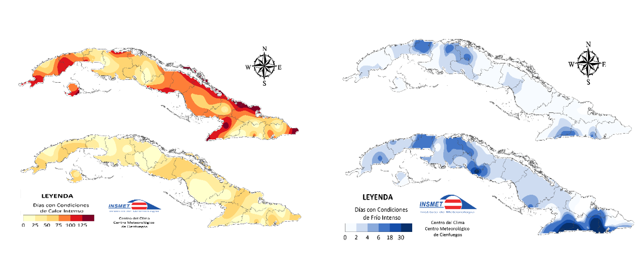State of the climate in Cuba 2021. Extended summary
Main Article Content
Abstract
This report presents a description of the state of the climate in Cuba during 2021, based on the analysis of climate indices and variable behavior, as well as some factors that regulate the climate variability in Cuba and the region. These indices provide the most relevant information in relation to last year's climate variations. The annual mean temperature was the third highest since 1951, reaching a value of 0.86°C above the historical average for the period 1961-1990. Correspondingly, 23 maximum temperature records were broken. The La Niña 2021-2022 event influenced the active hurricane season 2021. The annual accumulated rainfall was below the historical average in almost the entire country, which led to meteorological and agricultural drought.
Downloads
Article Details

This work is licensed under a Creative Commons Attribution-NonCommercial 4.0 International License.
Those authors who have publications with this journal accept the following terms of the License Attribution-NonCommercial 4.0 International (CC BY-NC 4.0):
You are free to:
- Share — copy and redistribute the material in any medium or format
- Adapt — remix, transform, and build upon the material
The licensor cannot revoke these freedoms as long as you follow the license terms.
Under the following terms:
- Attribution — You must give appropriate credit, provide a link to the license, and indicate if changes were made. You may do so in any reasonable manner, but not in any way that suggests the licensor endorses you or your use.
- NonCommercial — You may not use the material for commercial purposes.
- No additional restrictions — You may not apply legal terms or technological measures that legally restrict others from doing anything the license permits.
The journal is not responsible for the opinions and concepts expressed in the works, they are the sole responsibility of the authors. The Editor, with the assistance of the Editorial Committee, reserves the right to suggest or request advisable or necessary modifications. They are accepted to publish original scientific papers, research results of interest that have not been published or sent to another journal for the same purpose.
The mention of trademarks of equipment, instruments or specific materials is for identification purposes, and there is no promotional commitment in relation to them, neither by the authors nor by the publisher.
References
Fonseca, C., Hernández, D., Alpizar, M., González, I. T., Gil, L., Cutié, V., Martínez, M., Barcia, S., Vazquez, R., Hernández, M., Velázquez, B., Pérez, R., & Valderá, N. (2021). Estado del Clima en Cuba 2020. Resumen ampliado. Revista Cubana de Meteorología, 27(2), 18. http://rcm.insmet.cu/index.php/rcm/article/view/561
Hernández, M., Martínez, C. A., & Marzo, O. (2014). Consequences of sea level variability and sea level rise for Cuban territory. Proceedings of the International Association of Hydrological Sciences, 365, 22-27. https://doi.org/10.5194/piahs-365-22-2015
Hernández, M., & Marzo, O. (2009). Variabilidad estacional del nivel del mar en el Archipiélago cubano. Serie Oceanológica, 6, 15. http://oceanologia.redciencia.cu

